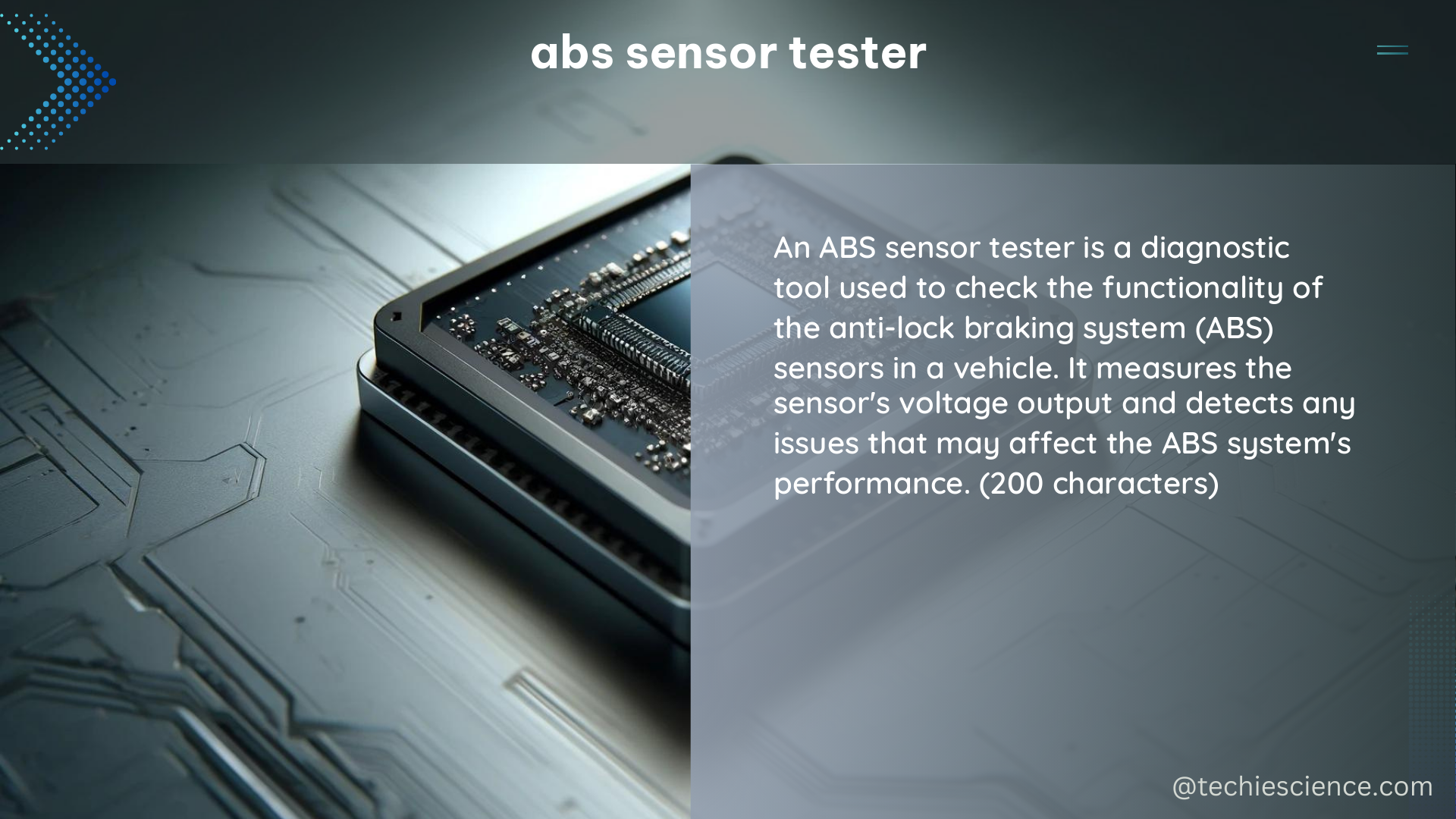The Anti-lock Braking System (ABS) is a crucial safety feature in modern vehicles, and the ABS sensor tester is an essential tool for diagnosing and repairing this critical system. This comprehensive guide will delve into the technical specifications, functionality, and step-by-step instructions for building a DIY ABS sensor tester, providing you with a valuable resource for maintaining the safety and performance of your vehicle.
Technical Specifications of ABS Sensor Tester
-
Measurement Range: The ABS sensor tester should be capable of measuring the frequency and amplitude of the alternating voltage induced by the wheel speed sensors, with a range typically spanning from a few Hertz (Hz) to several kilohertz (kHz), depending on the vehicle’s speed. This wide range ensures the tester can accurately assess the sensor’s performance across a variety of driving conditions.
-
Accuracy: The tester should have a high degree of accuracy in measuring the frequency and amplitude, with an error margin of less than 1%. This level of precision is essential for identifying even minor discrepancies in the sensor’s output, which can be indicative of potential issues.
-
Resolution: To detect even the smallest changes in the frequency and amplitude, the tester should have a high resolution, typically with a resolution of 0.1 Hz or better. This level of granularity allows for precise diagnosis and troubleshooting of the ABS system.
-
Data Processing: The ABS sensor tester should be equipped with advanced data processing capabilities, enabling it to analyze the measured data in real-time and provide diagnostic information to the user. This feature streamlines the troubleshooting process and helps identify the root cause of any ABS-related issues.
-
Connectivity: The tester should have a reliable and fast connection to the vehicle’s diagnostic interface, typically through a standard OBD-II (On-Board Diagnostics) port. This ensures seamless integration with the vehicle’s electronic systems and facilitates efficient data transfer.
-
Power Supply: The ABS sensor tester should have an internal rechargeable battery or the ability to be powered through a standard 12V DC power outlet, providing the necessary power for its operation and ensuring portability and convenience during use.
Building a DIY ABS Sensor Tester

Constructing a DIY ABS sensor tester can be a rewarding project for electronics enthusiasts. Here’s a step-by-step guide to building your own ABS sensor tester:
-
Sensor Interface: The tester should have a sensor interface that can connect to the vehicle’s ABS sensors, typically through a standard 4-pin connector. This interface should be designed to safely and securely interface with the vehicle’s electrical system without causing any damage.
-
Signal Conditioning: The tester should incorporate a signal conditioning circuit that can amplify and filter the measured signals from the ABS sensors. This circuit, typically based on operational amplifiers (op-amps), ensures the signals are properly conditioned for accurate measurement and analysis.
-
Frequency and Amplitude Measurement: The core of the ABS sensor tester is the frequency and amplitude measurement circuit. This can be implemented using a microcontroller or a dedicated integrated circuit (IC) that can accurately measure the frequency and amplitude of the signals from the ABS sensors. The measurement range and resolution should meet the specifications outlined earlier.
-
Data Processing and Display: The tester should have a data processing and display circuit that can process the measured data and present it to the user in a clear and intuitive manner. This can be achieved through the use of a microcontroller, a display module (such as an LCD or OLED), and appropriate software algorithms.
-
Connectivity and Power Supply: To ensure the tester’s versatility and ease of use, it should have a reliable and fast connection to the vehicle’s diagnostic interface, typically through an OBD-II port. Additionally, the tester should be powered by an internal rechargeable battery or be capable of being connected to a standard 12V DC power source, providing the necessary power for its operation.
By following these steps, you can build a comprehensive DIY ABS sensor tester that can accurately diagnose and troubleshoot issues related to the Anti-lock Braking System in your vehicle. Remember to carefully select high-quality components, adhere to safety guidelines, and thoroughly test the tester before using it on your vehicle.
Conclusion
The ABS sensor tester is a crucial tool for maintaining the safety and performance of your vehicle’s Anti-lock Braking System. By understanding the technical specifications and building a DIY ABS sensor tester, you can take control of your vehicle’s maintenance and ensure its braking system is functioning at its best. This comprehensive guide has provided you with the necessary information and step-by-step instructions to embark on your own ABS sensor tester project. Happy tinkering and safe driving!
References
- DEPARTMENT OF DEFENSE SMALL BUSINESS INNOVATION RESEARCH (SBIR) BAA 24-2, https://www.dodsbir.mil/submissions/api/public/download?fileName=DOD_SBIR_242_FULL.pdf&showOnWeb=true&uploadId=MTM3NjYwOQ%3D%3D
- DoD SBIR 23.1, https://www.sbir.gov/node/2281179
- Check and change ABS and wheel speed sensors – HELLA, https://www.hella.com/techworld/us/Technical/Sensors-and-actuators/Check-change-ABS-sensor-4074/
- AI for Science, Energy, and Security – Argonne National Laboratory, https://www.anl.gov/sites/www/files/2023-06/AI4SESReport-2023-v6.pdf

The lambdageeks.com Core SME Team is a group of experienced subject matter experts from diverse scientific and technical fields including Physics, Chemistry, Technology,Electronics & Electrical Engineering, Automotive, Mechanical Engineering. Our team collaborates to create high-quality, well-researched articles on a wide range of science and technology topics for the lambdageeks.com website.
All Our Senior SME are having more than 7 Years of experience in the respective fields . They are either Working Industry Professionals or assocaited With different Universities. Refer Our Authors Page to get to know About our Core SMEs.